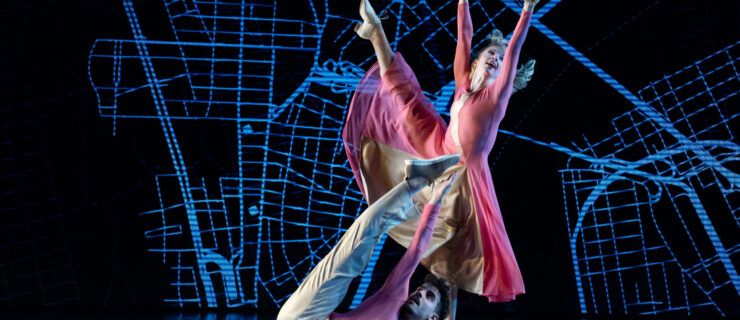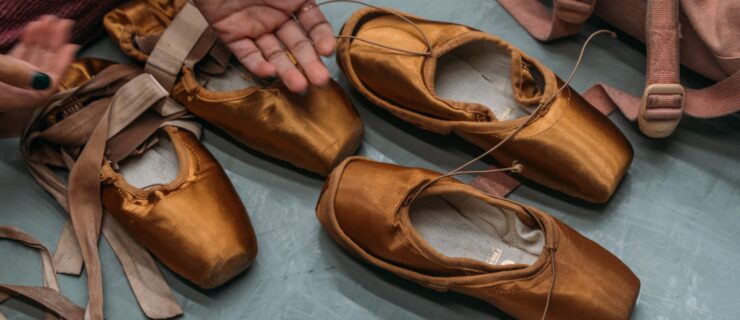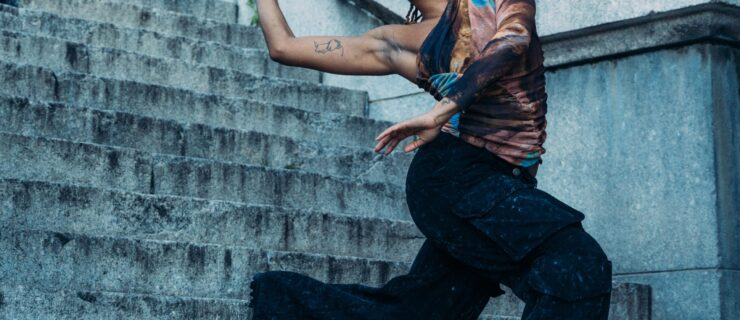Emma Portner's Unstoppable Career
Emma Portner is at a crossroads. At only 21 years old, she’s already had the kind of opportunities most seasoned pros dream of: starring in a viral dance video, choreographing for Justin Bieber, working on a Broadway-bound musical, teaching internationally and performing at venues like New York City Center. Portner is playing by her own rules and embracing the challenges of being a choreographer, company director and dancer in nearly every style—and all at once. So where will she take her career next? Where will she focus her time?
While a certain degree of success can be predicated on serendipity, it’s much more accurate to credit Portner’s intuition and tireless work ethic with getting her where she is today. She’s an incredibly focused, multi-hyphenate artist whose dedication to her craft has caused people across the entire industry to sit up and take notice. Powerful yet seemingly boneless, hip-hop infused and classically technical, she’s a melting pot of dance—instantly recognizable and almost impossible to imitate. The zillions of movement phrases she posts on Instagram prove you’re more likely to catch her sweat-soaked and alone in the studio than anywhere else. There are no posed shots and definitely no filter. Portner is showing just how cool it can be to put the effort in. And the payoff? Gig after gig in the contemporary, tap, commercial and Broadway worlds, and an industry that’s scrambling to catch up with her.
From Canada to NYC
Portner’s self-direction started early while training at Leeming Danceworks in Ottawa, Ontario. “I’ve been filming myself in the studio since I was 12 years old as a way to remember patterns, or break them,” she says. “I thought it was normal until I started telling people about it.” She attended summer intensives, including at The National Ballet of Canada, and, at 16, she moved to NYC for The Ailey School’s Certificate Program.
From Ailey, Portner diversified her training, spending a summer with RUBBERBANDance Group, the über-cool Montreal-based contemporary company directed by Victor Quijada, and two summers at Springboard Danse Montréal.
In a surprising move for most contemporary dancers, Portner has also trained in tap. She first took Michelle Dorrance’s class at NYC’s Broadway Dance Center in 2013, where she started, in Portner’s words, “struggling in the back corner, working my butt off.” She was a quick study: Portner went on to dance featured parts in the MacArthur fellow’s choreography and continues to perform with Dorrance’s company, Dorrance Dance.
Big Breaks
As a teen, Portner asked Leeming Danceworks’ director to invite choreographer Matt Luck to the studio. “We had an instant connection,” Portner recalls. Luck must have felt it too: He called Portner just a couple months later and asked her to collaborate on a dance video.
Portner fans will know that the result, “Dancing in the Dark,” catapulted Portner (and Luck) to a new level of visibility. “I never expected the video to generate the reaction it did,” Portner says. “Dancing in the Dark” went viral in 2012, and among its more than 640,000 viewers and fans was hip-hop choreographer Parris Goebel, who gave them a shout-out in the comments.
 Jayme Thornton
Jayme Thornton
It wasn’t long before Goebel reached out to Portner about a huge opportunity: the chance to collaborate on the music video for Justin Bieber’s “Life Is Worth Living.” “At first, I thought Parris was choreographing the video,” Portner says, “and I was really nervous because I’m nothing like the dancers she normally works with.” But Goebel wanted Portner to choreograph and had no doubts that she’d also be perfect in the video: “I wanted different styles for each song on the album, and I knew Emma would bring this one to life,” she says.
Goebel gave Portner free range to create the duet with partner Patrick Cook. “We had six hours to make a dance,” Portner says. “I did my best to make something that would be well received on a commercial platform, but still pushes the platform in a new direction.” If its 33 million-plus views are any indication, she succeeded.
The “Life Is Worth Living” video opened yet another door. Nick DeMoura, the creative director of Bieber’s Purpose World Tour, messaged Portner on Instagram and asked her to choreograph a piece of the tour. The catch? He wanted her to go to L.A. in January 2016, which Portner describes as the busiest month of her life. She’d just finished A Primitive Cinema—a major piece for her company (then named Flock’d Dance), supported by her second-runner-up win at the 2014 Capezio A.C.E. Awards— and was teaching at Intrigue Dance Intensive and performing with Dorrance Dance. Still, she couldn’t turn it down.
Despite the added pressure of working for one of the world’s biggest pop stars, Portner approached the experience with her usual blend of determination and research. “The tour was something so unlike me, but I’m really grateful for that opportunity. It opened me up to this elite world of artists that I never would have been exposed to,” says Portner. “Now, I’m experiencing an influx of people contacting me to work on their videos and tours, and I’m able to be specific about what I choose to do.”
Next Steps
Despite her newfound professional clout, Portner is still choosing to do everything. So far this year, she has revamped her company, renaming it Emma Portner and Artists; debuted and performed in a new work, Water that Came to My Waist; performed with Dorrance Dance in Dorrance’s Myelination; choreographed a music video for indie artist Blood Orange; and is collaborating with Dee Caspary on a bicoastal show.
As if that weren’t enough, she also went to London to start choreographing a new Broadway-bound musical, Bat Out of Hell, a contemporary take on rock singer Meat Loaf’s 1977 collaboration with composer Jim Steinman. The show premieres in Manchester, England, in 2017 before hitting London, Canada and, eventually, Broadway. “All of my 12-year-old dreams are coming true,” Portner says.
Even though her achievements are high-level, Portner’s expectations for herself are even higher. “I’m not ready to commit totally to choreographing or directing,” she says. “My body is at a point where I still have so much to discover. Right now, I’m interested in diving into contemporary ballet a little bit more.”
She continues: “I feel like I’m trying to do 700 things, but that’s what feeds my soul. I’m learning to play the piano and about neuroscience. I’m working to get nonprofit status for my company and a green card for myself. My attitude is always, ‘Do it. Make it happen.’ ”
Emma’s Choreography Workshop
 Jayme Thornton
Jayme Thornton
“I spend at least two hours a day exploring in the studio,” Portner says. “I record everything and then watch the whole thing forward and in reverse. I give myself tasks to improve my dancing.” Try some of Portner’s prompts the next time you’re in the studio. She often uses them to challenge herself as both a choreographer and mover:
- Test your extremes. Redefine your understanding of slow and fast, in and out of control.
- Only move with transition steps.
- Channel a dancer you admire.
- Partner the floor.
- Film an improvisation, and then quickly learn it. (“This one is hilarious because I geta glimpse into what it may be like to take my own class and pick up my own material. It’s frustrating!”)
Tapping Into Something Different
Sure, she’s got a hip-hop groove and sick contemporary skills. But Portner is equally at home in tap shoes, something that hasn’t gone unnoticed by tap icon Michelle Dorrance.
“I asked Emma to be part of my 2015 work, Myelination, because of her incredibly singular voice,” says Dorrance. “But what struck me most when first working with her was that she sought experiences as an ensemble member more than she did as a soloist. Not many dancers who receive so much individual attention prefer to humble themselves in an ensemble.” The respect is mutual: “Michelle constantly pushes me. She’s the only person to have ever ‘benched’ me as a dancer, and I love that,” says Portner—who, true to form, stuck with tap because of its difficulties. She also stresses the importance of learning tap dance history and culture, and how that knowledge benefits all dancers, not just tappers.
 Jayme Thornton
Jayme Thornton



